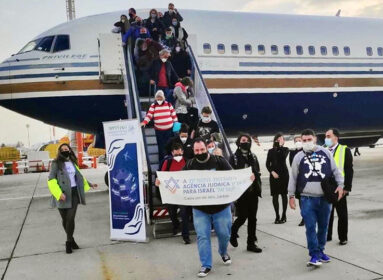
Jewish Ledger | 2-25-11
When starting Sifriyat Pijama, the PJ Library program in Israel, the Harold Grinspoon Foundation ran into a bit of a logistical snag they hadn’t expected.
It turns out Israeli mailboxes are too small to accept the books sent out to Jewish families by the PJ Library each month.
“Harold Grinspoon really wanted to bring PJ Library to Israel, but one of the realities that they ran into in looking at implementation was that the Israeli mailboxes were too small to accept the books. They knew Israeli families would not spend hours on line in the post office every month to get a book for their child,” said Iris Koller of PJ Library, which is headquartered in West Springfield, Mass.
Grinspoon’s staff came up with the idea of delivering books to Israeli children at their schools.
“Because the vast majority of Jewish children are attending a gan (nursery school), it was a way to really reach the wide breadth of children,” Koller explained.
Last year, PJ Library piloted the Sifriyat Pijama program in the Afula-Gilboa region in the gans of the Tali School system. The program was a huge success. Starting out with 3,500 children originally, the program, in partnership with the ministry of education, now sends books to 44,000 children throughout Israel.
For several years, The PJ Library, created by Harold Grinspoon, has sent Jewish books monthly to the homes of young children throughout the United States. In an effort to assist young families in their “Jewish journeys” the PJ Library sends Jewish-content books and music to children from age six months to five, six, seven or eight years.
Currently, The PJ Library is available in more than 100 communities across the U.S., and each program is sponsored by a local Jewish organization. Sending PJ Library books to schools in Israel sparked an idea back in the States. “Harold and others on the foundation began to see the success and started to think about what would happen if they brought a similar model to America,” Koller said. “Not taking away from the PJ Library and the value of parents engaging in Jewish life with children and reading books at home, but what would happen if in addition to that we provided books and resources and professional development to teachers in Jewish early childhood classrooms so that they were using the same books children were getting at home, again to use literacy as a springboard for learning and to infuse our classrooms with Jewish values and to capitalize and foster family engagement in not just the school but the larger community?”
That was the beginning of PJ Goes to School, a school-based initiative that was piloted in Jewish preschool programs in seven U.S. communities this year: Hartford, Western Massachusetts, Boston, Austin, Tex., MetroWest, N.J., San Francisco, and West Palm Beach, Fla.
In the Hartford area, the program is at the Mandell JCC, Solomon Schechter Day School and the Bess & Paul Sigel Hebrew Academy. In Western Massachusetts, PJ Goes to School is in the early childhood classes at Gan Keshet in Northampton, the Springfield JCC and Lubavitcher Yeshiva Academy.
PJ Goes to School provides copies of the monthly PJ Library books to these preschool classrooms, offers professional development to the teachers and teacher resource guides, and detailed suggestions for family engagement and learning activities.
Koller said that local day school preschools may not have an abundance of the kinds of books PJ Library offers.
“They actually really don’t always have the books because they are not always rich in resources and they are trying to get materials across every aspect of early childhood learning – books for large motor and fine motor and books about the seasons, and science and language,” Koller said.
“We feel fortunate to be receiving the PJ Library books,” said Wendy Stein, director of the Gan Keshet Preschool. “As a member of the PJ Goes to School Program, we are committed to integrating books we receive into our curriculum and making a home/school connection with the story.”
In December, Gan Keshet’s four-year-old class read “The Hannukah Trike” by Kathryn Mitter.
After reading “The Hannukah Trike,” four-year-old classroom teachers Peggy Walker and Lauren Miller discussed and explored the many ways the children have shown perseverance and patience through practice. As a home/school connection they asked families to bring in photos of the children learning and or mastering a new skill. They used the photos to make a class puzzle which is now available during drop off for families to admire and rebuild.
“The excitement was actually looking at what others have accomplished. Now that’s building community!” said lead teacher, Peggy Walker.
The three- and four-year-old preschool classes at the Mandell JCC in West Hartford, Conn., have been getting the PJ Goes to School books and CDs since December, said Rhonda Wirth, director of the JCC preschool program.

Teachers from Hartford area Jewish preschools at a recent training session for PJ Goes to School included (standing, left to right) Debbie Levy, Kathleen Walsh, Paula Baram of the Mandell JCC; Regina Miller, Sigel Hebrew Academy; Barbara Checknoff, Solomon Schechter Day School (SSDS); Emily Bufaro, Amy Gurchin, Kim Little, Mandell JCC; (seated, left to right), Bonnie Schneider, SSDS; Lisa Lebowtiz, Mandell JCC’s Shirley Reeback Preschool in Glastonbury.
“The nice part about it is that it is a very flexible system so it is not like a standard curriculum coming in and saying, ‘Okay, here is the book and this is what you are discussing and this is how you should use it,’” Wirth said.
The school’s three and four-year olds get different materials, she said. Each class gets three copies of the book a month.
“We read the stories in class, as well as send the books home with the children, and leave a book available to them for free reading at all times,” Wirth said.
And the books can be used in a variety of ways.
“We build on what their interests are. We got “The Chanukah Guest” – featuring a bear – in December, but some of our classrooms took it out again because we are talking about bears and hibernation. We are finding them to be very helpful in continuing the themes throughout the year.”
The reaction has been very positive, Wirth said.
“The children are really excited about it, especially the ones who already get the books [through The PJ Library]. They say, ‘Oh, I have that book at home!’” Wirth said. “The parents are always thrilled when we are talking about mitzvahs and ethics and values, which are so universal, so being Jewish or not Jewish, it is a nice addition to the program.”








 Southern New England Jewish Ledger
Southern New England Jewish Ledger














